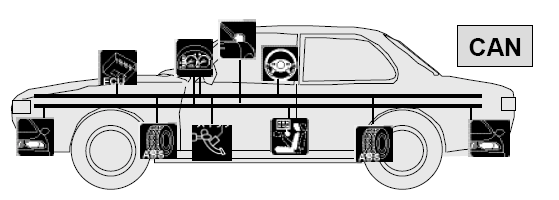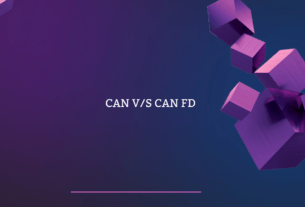The Controller Area Network (CAN) bus is a widely used communication protocol in modern vehicles, industrial machinery, and other applications that require real-time data exchange between electronic control units (ECUs). However, like any other communication system, the CAN bus can encounter issues that can lead to malfunctioning of the network and Troubleshooting CAN Bus Issues is very important. In this article, we will discuss some of the common CAN bus issues and troubleshoot those CAN Bus Issues.
Bus Off Error:
The Bus Off error is one of the most common and critical issues that can occur in a Controller Area Network (CAN) bus network. It occurs when a node on the CAN bus sends too many error frames, leading to the node being disconnected from the network.
When a node detects an error on the network, it sends an error frame to all other nodes on the bus. If a node repeatedly sends error frames without receiving any acknowledgment, the node goes into a Bus Off state. In this state, the node stops transmitting on the network, and it is disconnected from the bus.
A Bus Off error can be caused by several factors, including faulty wiring, incorrect termination, or a malfunctioning transceiver. In addition, the Bus Off error can also be caused by software errors, such as a poorly implemented error handling algorithm.
When a Bus Off error occurs, it is essential to troubleshoot and fix the issue as quickly as possible to ensure the optimal performance of the network. To troubleshoot this error, start by checking the physical layer of the network. Verify that the cables are connected correctly, and the termination resistors are present and of the correct value. Also, check the transceiver for any signs of damage or malfunction.
To prevent Bus Off errors, it is recommended to follow the proper installation guidelines and best practices for CAN bus networks. This includes using high-quality cables and connectors, ensuring correct termination, and implementing error handling algorithms correctly.
Bit Errors:
Bit errors are another common issue that can occur in a Controller Area Network (CAN) bus network. A bit error occurs when the signal on the CAN bus is distorted, leading to incorrect data transmission. This can result in corrupted messages or even complete communication failure between nodes on the network.
Bit errors can be caused by a variety of factors, including electrical noise, voltage fluctuations, and electromagnetic interference. The most common cause of bit errors is noise, which can originate from a variety of sources, including power supplies, motors, and electrical wiring.
To troubleshoot bit errors, start by checking the wiring and ensuring that the cables are well-shielded to prevent electrical interference. It is also important to check the ground connections and the power supply to ensure they are stable. Using high-quality cables and connectors can help prevent bit errors from occurring in the first place.
It is also important to note that bit errors can accumulate over time, leading to a gradual degradation of network performance. To prevent this, it is essential to implement error detection and correction algorithms. For example, CAN uses a bit stuffing mechanism that adds additional bits to the data stream to ensure that bit errors are detected and corrected.
Frame Errors:
Frame errors are another type of error that can occur in a Controller Area Network (CAN) bus network. A frame error occurs when the CAN controller detects an error in the message frame being transmitted. This error can result in a corrupted message or even complete communication failure between nodes on the network.
Frame errors can be caused by several factors, including electrical noise, incorrect bus timings, and improper wiring or termination. For example, if the CAN controller detects a bit level that is different from the expected value during the message transmission, it will generate a frame error.
To troubleshoot frame errors, start by checking the wiring and ensuring that the cables are well-shielded to prevent electrical interference. Also, check the bus timing and ensure that it is set correctly to prevent timing-related issues. It is also essential to ensure that the termination is correct and that the termination resistors are present and of the correct value.
In addition, it is crucial to check the message length and data format to ensure that they are correct. For example, if the message length is too long, it can result in a frame error.
To prevent frame errors, it is recommended to follow best practices for wiring and termination, use high-quality cables and connectors, and ensure that the bus timing is set correctly. Implementing error detection and correction algorithms can also help detect and correct frame errors before they cause significant issues on the network.
Stuck-at Dominant/Recessive:
Stuck-at Dominant and Stuck-at Recessive are types of errors that can occur in a Controller Area Network (CAN) bus network. These errors occur when a node on the network becomes unable to switch from a dominant (logic low) or recessive (logic high) state, resulting in incorrect data transmission.
A Stuck-at Dominant error occurs when a node is stuck in a dominant state and is unable to switch to a recessive state. This can cause the node to continually transmit dominant bits, leading to communication failures on the network.
On the other hand, a Stuck-at Recessive error occurs when a node is stuck in a recessive state and is unable to switch to a dominant state. This can cause the node to continually transmit recessive bits, also leading to communication failures on the network.
Stuck-at errors can be caused by several factors, including damaged or faulty transceivers, damaged wiring or connectors, or problems with the power supply. To troubleshoot these errors, start by checking the wiring and connectors for any damage or loose connections. Also, check the power supply and ensure that it is providing stable and sufficient power to the network.
To prevent Stuck-at errors, it is recommended to use high-quality transceivers and follow best practices for wiring and connectors. Implementing error detection and correction algorithms, such as the CRC (Cyclic Redundancy Check), can also help detect and correct these errors before they cause significant issues on the network.
Missing ACK
Missing ACK (Acknowledgment) is another common issue that can occur in a Controller Area Network (CAN) bus network. In CAN, ACK is a signal that is sent by the receiving node to acknowledge that it has received a message from the transmitting node. When a transmitting node does not receive an ACK signal, it assumes that the message was not received correctly, and a communication failure can occur.
Missing ACKs can be caused by several factors, including incorrect termination, network overload, and incorrect or damaged wiring or connectors. For example, if the CAN bus is not properly terminated, it can cause reflections that can interfere with the ACK signal, resulting in a missing ACK.
To troubleshoot missing ACKs, start by checking the wiring and connectors for any damage or loose connections. Also, check the termination and ensure that it is correct and properly installed. It is also important to check the network load and ensure that it is not too high, which can cause delays in ACK signals.
To prevent missing ACKs, it is recommended to follow best practices for wiring and termination and use high-quality cables and connectors. Implementing error detection and correction algorithms, such as the CRC (Cyclic Redundancy Check), can also help detect and correct missing ACKs before they cause significant issues on the network.
In conclusion, the CAN bus is a powerful communication protocol that enables real-time data exchange between electronic control units. However, like any other communication system, it can encounter issues that can lead to malfunctioning of the network and Troubleshooting CAN Bus Issues is critical. By understanding the common problems and their solutions, you can troubleshoot and fix CAN bus issues quickly and efficiently, ensuring optimal performance of the network.



